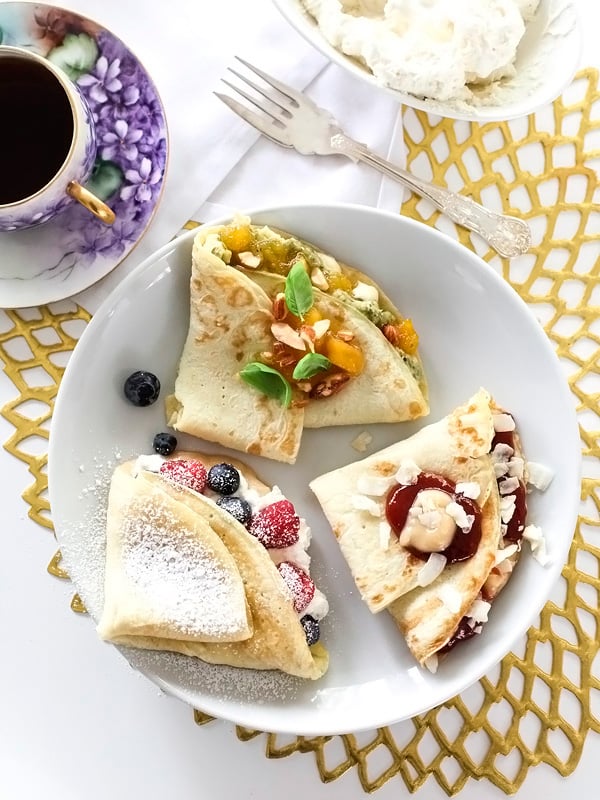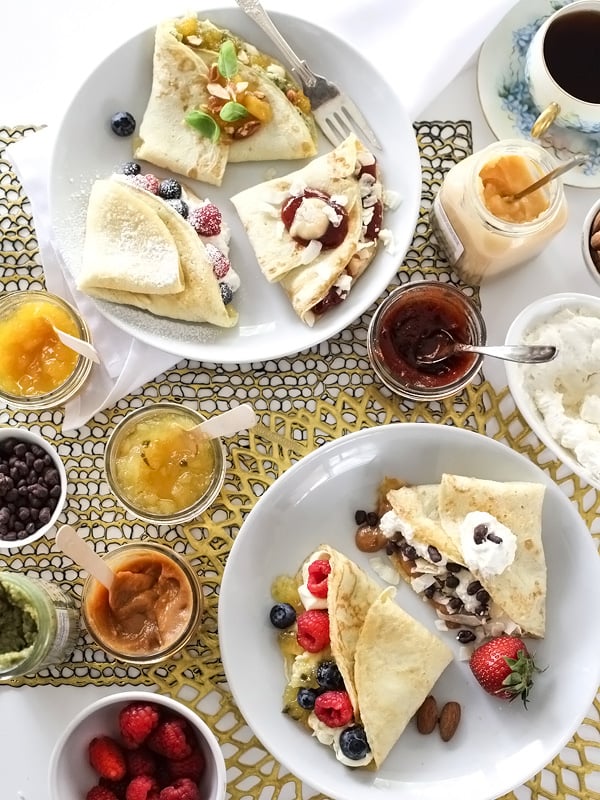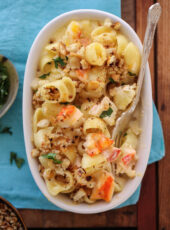These delicate and buttery French crêpes are so delicious, easy to make, and customizable with whatever sweet or savory fillings your heart desires. They’re perfect for breakfast, brunch, lunch, or even dinner!
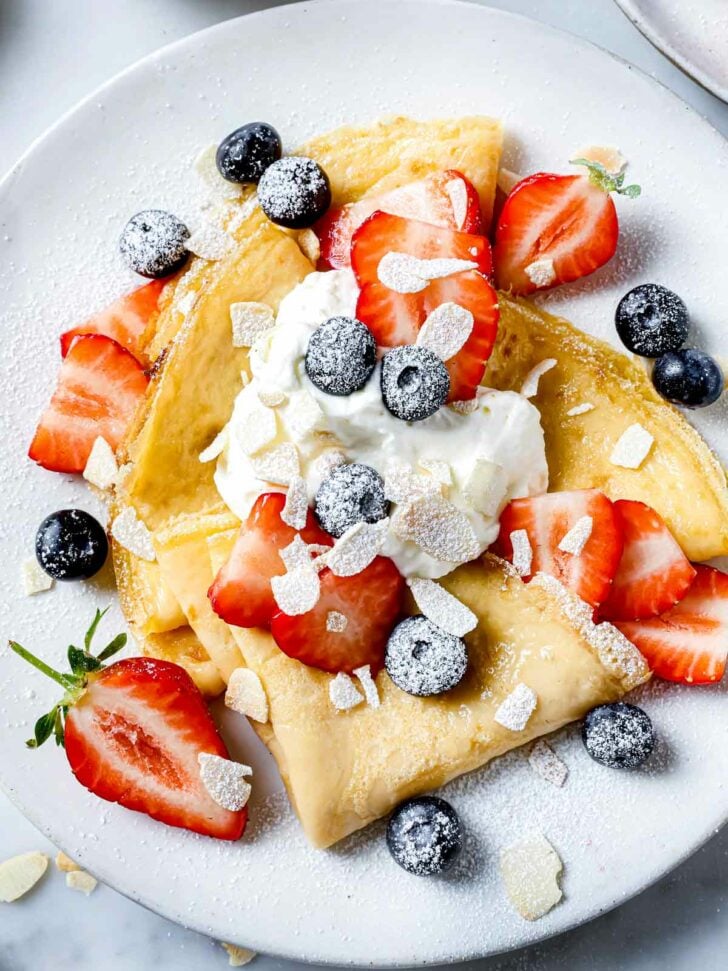
I love my pancakes, but when it comes to hosting brunch, crêpes (and also Dutch babies) are my favorite thing to make when I want to impress with little effort involved. They’re fun to eat and everyone feels fancy and transported to France when eating them, yet they’re deceptively simple to make at home. It’s a win-win. Plus, it’s fun to have a variety of sweet and savory fillings so folks can enjoy the best of both worlds.
My easy crêpe recipe yields the lightest, laciest crêpes in no time and can be made in a blender. You want to let the batter rest for about an hour so the gluten can relax and the crêpes will be nice and light. This is a good time to flit around the kitchen or prep whatever fillings you’d like. Cue the French music, let’s make some crêpes!
In This Post
How Are Crêpes Different From Pancakes
Crêpes are lighter, thinner, and more delicate than traditional pancakes. They’re also larger. The edges are slightly crispy and they have a lacy-like quality to them the way they cook up. In terms of the ingredients, however, there really isn’t a difference—only crêpe batter is usually a bit thinner than pancake batter.
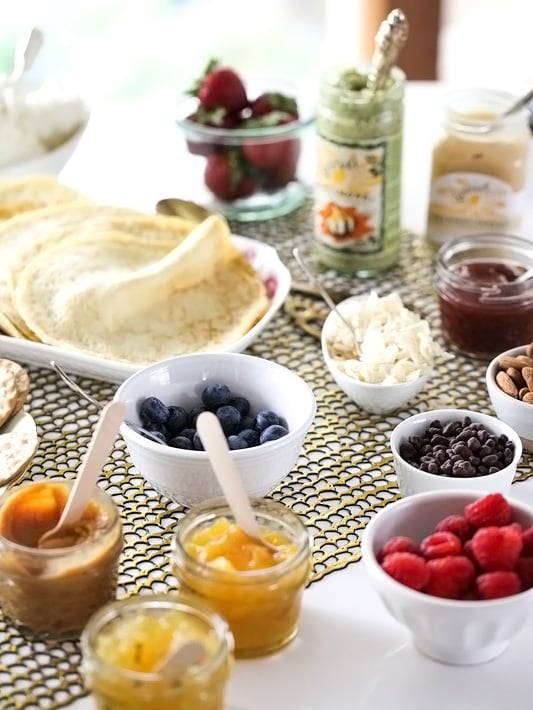
What’s in These Crêpes
These delicate and buttery French crêpes are so delicious, easy to make, and customizable with whatever sweet or savory fillings your heart desires. They’re perfect for breakfast, brunch, lunch, or even dinner.
All you need is 4 ingredients (not including salt, water, or any fillings) to make these crêpes. Here’s what you’ll need:
- Eggs
- Milk
- Water
- All-purpose flour
- Kosher salt
- Butter—don’t be shy, crêpes need fat and you don’t want them to stick to your pan
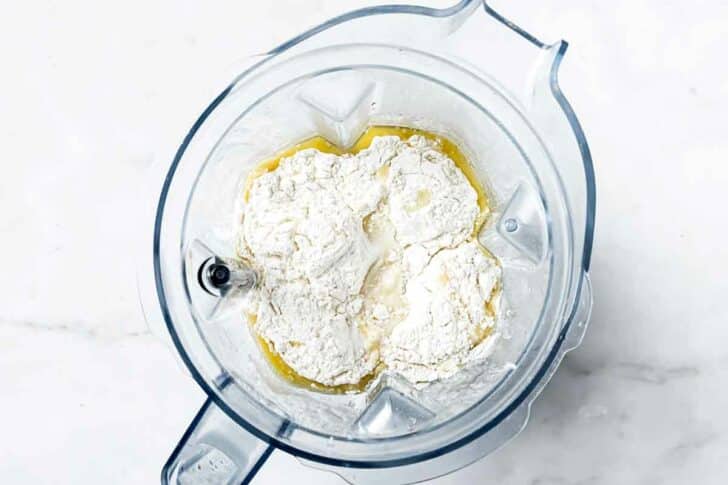
How to Make The Best Crêpes
Making crêpes at home only requires a few easy steps. Here’s how to make them: Blend, baby, blend then let the batter rest for at least one hour. Mix all your ingredients in a blender on high speed, then let your batter sit at room temperature for about an hour. This allows the flour to expand and some of the bubbles to relax. Alternatively, you can let the crêpe batter refrigerate overnight, just be sure to leave it on the counter an hour or so before using so it can come to room temperature. Prep your pan. Preheat a 6 or 7-inch nonstick skillet or crepe pan over medium heat. Once hot, butter it up (and don’t be shy!) You can use either a specialty crêpe pan (and look like a serious pro with this one) or be like me and use a 7-inch, non-stick egg fry pan (just remember to add butter to the pan before cooking each crêpe.
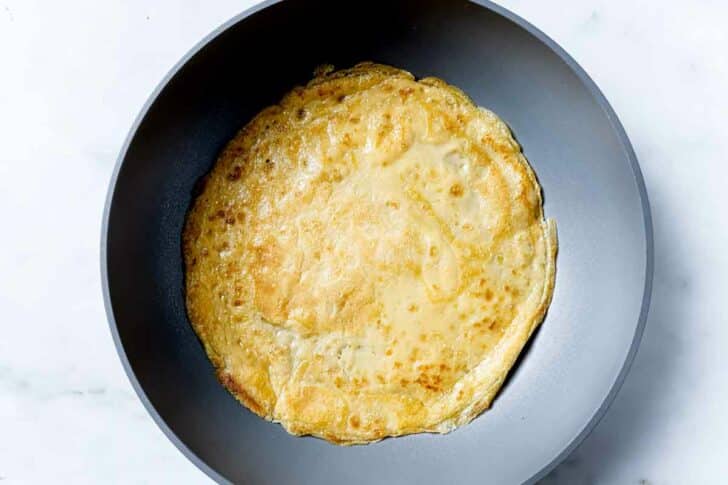
How to Cook Crêpes
Batter up. Pour the batter into the center of the skillet. Use ¼ cup or your crepe will be too thick. Move the skillet around, tilting it so the batter spreads to the edges. Cook until the surface is bubbly then carefully flip the crêpe (with your fingers or a spatula) and cook on the other side. As you make, stack them with pieces of wax paper or parchment between them so they don’t stick. Spread and fold. To layer with spreads and other toppings, spread ¼ of the crêpe with filling, fold in half and then fold over again. Top with more spreads, toppings, or powdered sugar.
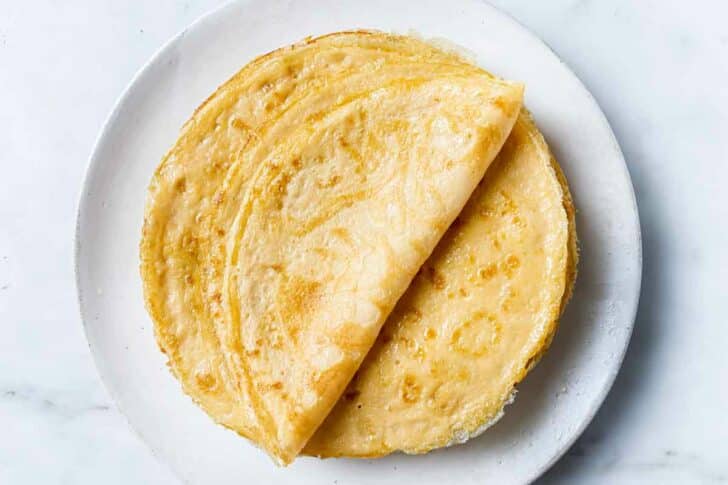
What is The Secret to Great Crêpes
While making crêpes at home are simpler than you would think, there are some helpful tips and tricks for making really good crêpes.
- Blenders are the best. You can certainly use a bowl and whisk to blend your crêpe batter, but a blender is key for creating the silkiest batter.
- Give it a rest. If you can plan ahead and rest your crêpe batter for an hour or so, that’s ideal because it allows the gluten to rest so the crêpes will be nice and light. You can rest the batter at room temp for an hour or two or refrigerate overnight (just remember to let the batter come to room temp again before cooking).
- Find your sweet spot. I have a gas stove and medium heat is my crêpe making happy spot. With a little practice, you’ll find yours—the key is sticking with an even level of heat.
- Commit to the flip. Don’t flip those babies until they’ve nearly completely set on the top then one flip is all they need. And don’t overthink it—flip quickly and with confidence!
- Get creative. Both when it comes to fillings and with the presentation. You can fold your crêpes in quarters (this is usually my preferred method), or roll them like a burrito.
Crêpe Filling Combinations
Mix and match the flavors and toppings for mouth-popping bites. Better yet, if you’re entertaining, set up a little bar where folks can choose their own fillings.
- Brie, pineapple jalapeño jelly, and fresh berries
- Dulce de leche, coconut spread, cocoa nibs, and coconut flakes
- Coconut spread, fresh berries, whipped cream, and powdered sugar
- Guava jam, coconut spread, flaked coconut
- Goat cheese, chimichurri spread, mango spread, almonds, fresh basilCr
Savory Filling Ideas for Crêpes
- Soft cheeses like brie, goat cheese, ricotta, mascarpone, or Boursin
- Fresh herbs like basil, tarragon, mint, and chives
- Sautéed mushrooms, spinach, tomato, and caramelized onions
- Stewed chicken or pulled pork
- Ham, pancetta, or bacon
- Peanut or almond butter
Sweet Filling Ideas for Crêpes
- Fresh strawberries, raspberries, pomegranate seeds, or blueberries
- Fresh fruit like bananas, kiwi, pineapple, or star fruit
- Cream cheese and jam
- Caramelized bananas or apples
- Toasted coconut flakes or granola
- Chocolate-covered cocoa nibs or chocolate chips
- Nutella, peanut butter, or almond butter
- Whipped cream or whipped mascarpone cream sweetened with powdered sugar and vanilla extract or almond extract
- Yogurt or ice cream
- Sugar mixed with lemon or orange zest
- Almonds, pistachios, macadamia nuts, walnuts, or pecans
- Maple syrup, caramel sauce, honey, or hot fudge
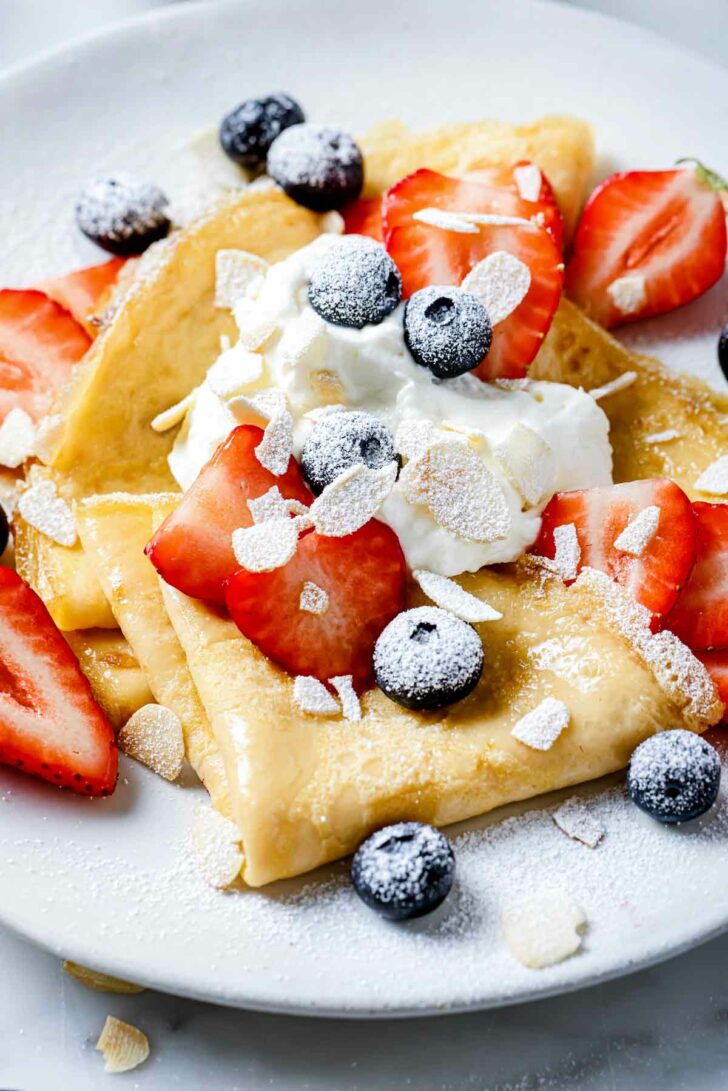
How to Freeze Crêpes and Store Crêpes for Later
Storing batter: Batters can be stored, covered, in the refrigerator overnight. Don’t store for longer than 24 hours. Storing cooked crepes: Store in an airtight container, in a plastic bag, or wrapped in foil for 2-3 days. How to freeze crepes: Cooked, unfilled crepes can be frozen for up to 4 months when tightly sealed in freezer bags. Place wax paper between each crepe or at least between every 4-6 crepes. Bring stored crepes to room temperature before separating them.
What to Serve With Crêpes
- Berry Delicious Fruit Salad
- Classic Waldorf Salad
- Strawberry Caprese Pasta Salad
- Cantaloupe and Mozzarella with Prosciutto Caprese Salad
- Strawberry Arugula Salad with Watermelon and Feta
If you make this recipe, please let me know! Leave a ⭐️⭐️⭐️⭐️⭐️ rating on this recipe below and leave a comment
Delicious Crêpes with Both Sweet and Savory Flavors
Ingredients
- 4 large eggs
- 1 cup milk (whole milk is best)
- 1 cup water
- 1 ¼ cups sifted all-purpose flour
- 3 tablespoons butter plus more for cooking , melted
- ½ teaspoon kosher salt
- Stuff crepes with:
- fresh berries or sliced fruit
- assortment of jams or preserves
- savory or sweet spreads
- soft cheeses
- sautéed vegetables like spinach, onions, or mushrooms
- whipped cream
- nuts , chocolate, coconut, fresh herbs
Instructions
- Mix all ingredients in a blender on high speed for about a minute. Let sit at room temperature for about an hour. (Alternatively, you can let the crêpe batter refrigerate overnight, just be sure to leave it on the counter an hour or so before using so it can come to room temperature).
- Preheat a 6 or 7-inch nonstick skillet over medium heat. Once it’s nice and hot, melt about a teaspoon or so of butter in the skillet (alternatively you could brush the skillet with melted butter), and use a ¼ cup measuring cup to pour the batter into the center of the skillet, moving it around so the batter spreads to the edges. Cook until the surface is bubbly then carefully flip the crêpe (with your fingers or a spatula) the crêpe and cook on the other side. Remove from the heat, place on a plate, and cover with another plate until ready to use. Be sure to butter the skillet in between making your crêpes.
- To layer with spreads and other toppings, spread ¼ of the crêpe with filling, fold in half and then fold over again. Top with more spreads, toppings, or powdered sugar.
- Crêpes can be made several hours before serving and kept at room temperature.
Notes

More Brunch Recipes to Try
- THE BEST Dutch Baby (German Pancake)
- Easy Quiche Lorraine
- The Best Banana Bread Pancakes
- Bagel and Lox DIY Brunch Bar
- The BEST Traditional Eggs Benedict
.Follow me on Instagram, Facebook, Pinterest for more FoodieCrush inspiration.As always, thank you for reading and supporting companies I partner with, which allows me to create more unique content and recipes for you. There may be affiliate links in this post of which I receive a small commission. All opinions are always my own.
